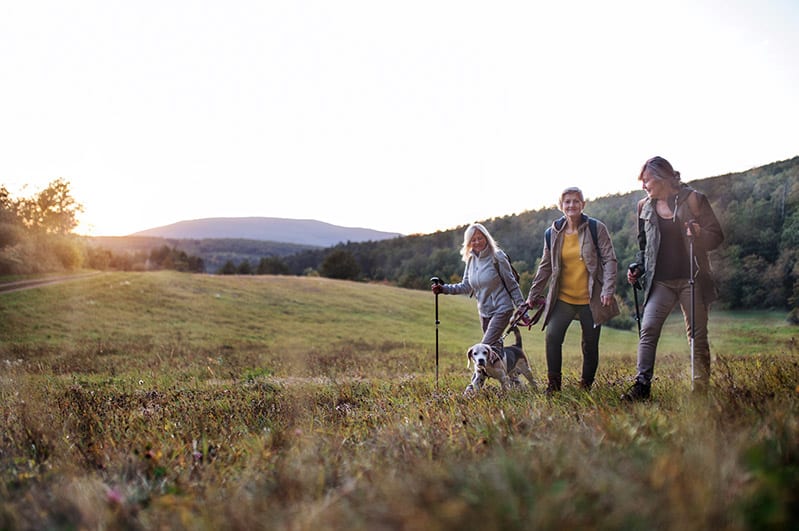Summary
Discover Beth Coker's simple yet transformative “exercise prescription.” Learn how walking can improve your physical and mental health, enhance your mood, and fit seamlessly into your daily routine. No special equipment or significant investment required, just a commitment to take the first step.
Sedentary to active, urban to rural, old to young — anyone can take Beth Coker’s “exercise prescription.”
The Asante exercise physiology manager works with patients recovering from heart surgery and other cardiovascular trauma, for whom she prescribes walking. It’s the most fundamental form of musculoskeletal movement that yields the most reliable results, she said.
“That’s their most low-impact exercise.”
Low-impact, however, doesn’t equate to a proverbial walk in the park. Given an introductory six-minute walking test, new patients often become winded, or their muscles give out, said Coker.
Coker’s patients “exercise their way back,” using methods that transcend clinical settings. Anyone lacking a regular exercise routine, she said, who just wants to get moving has myriad motivations to walk. Here are five reasons to take that first step.
1. Walking requires no special equipment or monetary expenditure.
A comfortable pair of grippy-soled, flat-heeled shoes essentially are the only accessory to one’s own two feet. Start walking on a level surface, usually sidewalks around your neighborhood, for 20 to 30 minutes per day, said Coker. Once flat ground is easily traversed, walk up an incline.
“It’s a gradual buildup of endurance and strength,” said Coker. “As they get stronger, we encourage them to walk up hills.”
Increase cardiovascular intensity by speeding up, using a stopwatch to verify traveling the same distance in shorter amounts of time, said Coker. Aim to walk six days per week, she said.
“Walking is affordable for everybody, and you can do it everywhere.”
2. Walking easily fits into everyday routines.
A narrow exercise window is no excuse. Three 10-minute walks each day are an acceptable substitute for 30 minutes all at once, said Coker.
“It’s that accumulation throughout the day.”
A pedometer helps intermittent walkers track their steps — about 10,000 minimum per day. Those add up trekking from car to storefront when shoppers park farther away. Or take stairs instead of elevators and escalators, said Coker.
Given the average person’s stride, 10,000 steps pencil out to about 5 miles. And while walkers don’t need to break a sweat to reap benefits, Coker dismisses the notion that a trip to Costco — no matter how crowded the parking lot — fills one’s daily exercise prescription.
“And sometimes you just want to laugh: ‘That is not exercise!’”
3. Walking can build relationships and boosts your mood
A new walking regimen, said Coker produces an “overall feeling of wellbeing right away.” Increased energy, reduced stress, better sleep and more mental clarity and focus also result, she said. For post-surgical patients in particular, walking brightens their overall outlook on life, said Coker.
“They come in with a lot of anger, a lot of depression.”
Anyone can literally walk away from heavy emotions for a part of each day. Bringing along a friend or furry companion extends the enjoyment, and either can serve as an “accountability partner,” said Coker.
“People enjoy social walking,” she said. “Get a dog; a dog needs to be walked — we’re serious.”
And walking is arguably the most natural way to observe the natural world, a proven practice for enhancing mental health.
4. Walking invites exploration of your surroundings
Spaces for walking abound, but nature’s novelty comes through seasonal change. From spring wildflowers on the Table Rocks to fall colors in Ashland’s Lithia Park, the region’s signature sights keep boredom at bay.
“We encourage them to vary where they’re walking,” said Coker. “As they get stronger, we encourage them to walk the Britt woods.”
Hills outside Jacksonville offer miles of trails, beginning at Britt Gardens and stretching to Forest Park, which is mostly shaded in summer. Walking in warmer months does come with Coker’s commonsense caution to wear sunscreen and a hat and stay hydrated.
5. Walking lowers the risk of disease and improves overall health
Rates of heart disease, diabetes, osteoporosis and some types of cancer are reduced in people who walk, said Coker. They lower their cholesterol, gain muscle strength, raise their metabolism, shed excess body fat, increase bone density and even correct their posture.
“Walking is your highest net level of calorie burning,” said Coker. “It strengthens your bones. Walking and lifting weights are the only two sure ways to build bone density.”
Better digestion is realized almost immediately by walking, although body fat reduction does take longer, said Coker. Once patients reach a healthy weight, walking is one of the best ways to maintain it, she said.
And if these benefits aren’t reason enough to walk, consider a well-known Chinese proverb: The journey of a thousand miles begins with a single step. Call it the first leg on a lifelong walk to wellness.









